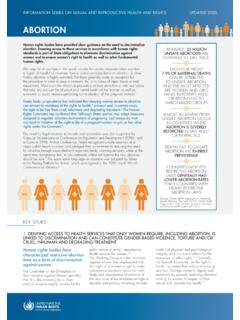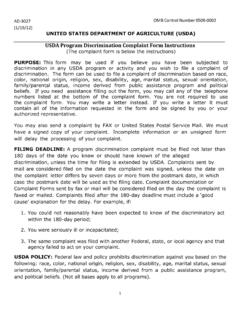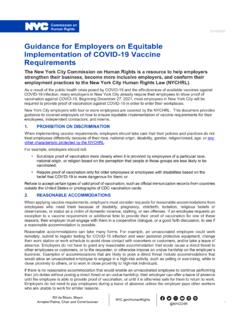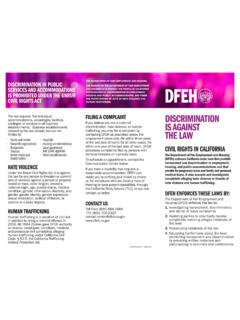Transcription of CHAPTER 2. THEORIES OF DISCRIMINATION
1 , CHG-1 CHAPTER 2. THEORIES OF DISCRIMINATION 2 1 INTRODUCTION In order for a particular fact pattern to be covered by the Fair Housing Act, three elements must be present: (1) a covered property; (2) a covered transaction; and (3) a covered basis of DISCRIMINATION . Covered properties are generally dwellings that are not subject to any of the Act's exemptions. Covered transactions, also referred to as subject matter jurisdiction ( , a refusal to rent), are set forth in Sections 804;806 and 818 of the Act. There are seven covered bases of DISCRIMINATION : race; color; religion; sex; disability; familial status; and national origin. See a discussion of these subjects in CHAPTER 3, Jurisdiction. Only behavior that involves one or more of these seven covered bases of DISCRIMINATION is illegal under the Fair Housing Act. Thus, for example, a landlord who refuses to rent an apartment to a prospective tenant has not thereby violated the Act -- even though a covered practice and a covered property may be involved --,unless it can also be shown that the landlord's action was based on race, color, religion, sex, disability, familial status, or national origin.
2 If the landlord's action was based on any other factor ( , the prospect's bad credit), no violation of the Act has occurred. This CHAPTER deals with how it may be shown that one of the seven covered bases of DISCRIMINATION was involved in a housing practice, thereby rendering that practice illegal under the Fair Housing Act. The starting point in analyzing this issue is the language used in the key substantive provisions of the Act. This language prohibits various housing practices ( , refusals to rent, sell, and negotiate and the imposition of discriminatory terms or conditions) "because of," "based on," or "on account of" any one of the seven prohibited bases of DISCRIMINATION . 11/98 2-1 , CHG-1 What do these phrases mean? Clearly, a phrase like "because of" would apply when the sole reason for a respondent's action is the race, color, religion, sex, disability, familial status, or national origin of the person with whom he is dealing. A more difficult issue is presented when a respondent's behavior is prompted by a number of reasons, only one of which is prohibited by the statute.
3 And what of a respondent who acts without any illegal motive, but who employs a policy that disproportionately excludes racial minorities or other groups protected by the Act? The Supreme Court has not yet decided a Fair Housing Act case dealing with these matters. The Court has, however, issued numerous opinions on the standards for proving a violation under the federal employment DISCRIMINATION law (Title VII of the Civil Rights Act of 1964), and the lower courts have generally hel4 that these precedents from the employment DISCRIMINATION field should be followed in interpreting the Fair Housing Act. Under Title VII, a plaintiff may pursue a claim under either a disparate treatment theory (discriminatory intent) or a discriminatory impact theory (discriminatory effect). The Supreme Court has explained the difference between these two THEORIES as follows: "Disparate treatment" .. is the most easily understood type of DISCRIMINATION . The employer simply treats some people less favorably than others because of their race, color, religion, sex, or national origin.
4 Proof of discriminatory motive is critical.. Claims of disparate treatment may be distinguished from claims that stress "disparate impact." The latter involve employment practices that are facially neutral in the treatment of different groups but that in fact fall more harshly on one group than another and cannot be justified by business necessity. Proof of discriminatory motive, we have held, is not required under a disparate-impact theory.. Either theory may, of course, be applied to a particular set of facts. 11/98 2-2 , CHG-1 Within the disparate treatment (discriminatory intent) category, two types of cases have been recognized: (1) cases in which the respondent's decision was motivated by a single consideration, and the problem is to determine whether that consideration was a legitimate one or one condemned by the statute; and (2) "mixed-motive" cases in which both legitimate and illegitimate considerations played a part in the respondent's decision.
5 The first of these two categories has accounted for. the vast majority of fair housing claims, although some "mixed-motive" cases have also been presented. And on occasion, both THEORIES may be used in the same case, although it is important in this situation to keep in mind the distinctions between how these two approaches are used to analyze the respondent's motivation. This CHAPTER discusses the analytical structure and the proof necessary to establish and rebut the three types of claims -- single-motive, mixed-motive, and discriminatory impact -- that have been recognized under the Fair Housing Act. Single-motive claims are dealt with in Section 2-2, which includes a discussion of the types of direct and circumstantial evidence that are most often used to prove this type of case. Mixed-motive claims are analyzed in Section 2-3. Section 2-4 is devoted to claims based on the discriminatory impact theory. Throughout this CHAPTER , it is assumed that the standards for proving a violation are the same regardless of whether a case involves DISCRIMINATION on the basis of race, color, religion, sex, disability, familial status, or national origin.
6 This assumption is supported by the fact that the language of the Fair Housing Act generally does not distinguish between these types of DISCRIMINATION .) Thus, when an example given in this CHAPTER deals with a particular basis of DISCRIMINATION ( , race or familial In cases involving DISCRIMINATION based on disability, there are additional forbidden practices, such as a refusal to make reasonable accommodations. These special disability provisions are discussed in CHAPTER 8. 11/98 2-3 , CHG-1 status), the text should be understood to apply to all of the seven bases of illegal DISCRIMINATION under the Act. 2-2 SINGLE-MOTIVE INTENT CASES A. Introduction The Fair Housing Act prohibits intentional DISCRIMINATION in a covered housing practice on the basis of race, color, religion, sex, disability, familial status, or national origin. The command of the law is that these seven bases for distinguishing among homeseekers must be irrelevant to a housing decision.
7 A respondent who consciously relies on any one of these illegal factors in discriminating with respect to a covered housing practice violates the Act. And this is so regar4less of whether the respondent bears any ill will or hostility towards whatever protected group is involved in the case; proof of the respondent's personal prejudices is not required to establish a violation of the Act. Cases alleging intentional DISCRIMINATION account for most of the litigation under the Fair Housing Act. The key in virtually all of these cases is determining whether the respondent did in fact act on the basis of the alleged illegal motive or rather acted on the basis of some other, non-prohibited consideration. A typical case might involve a landlord's refusal to rent an apartment to a black homeseeker, who then alleges that the reason for the landlord's refusal was racial DISCRIMINATION . The landlord usually responds by claiming that his reason for not dealing with the complainant was some legitimate concern, such as the desire to rent the apartment to a better qualified tenant.
8 The resolution of such a case will turn on the determination of what the landlord's real motivation was. Housing providers have a right to turn down applicants on any honest basis unrelated to the seven protected factors banned by the Fair Housing Act. On the other hand, if the evidence shows that the landlord did not actually rely on the claimed legitimate reason 11/98 2-4 , CHG-1 ( , because the white applicant who was eventually accepted for the unit was actually less qualified than the complainant), then this reason will appear to be simply a "pretext" for the landlord's unlawful motivation in refusing to deal with the minority complainant. B. Direct and Indirect Evidence of Unlawful Motive Evidence of the respondent's discriminatory motive may be either direct or indirect. Direct evidence is defined as evidence that "proves [the] existence of [the] fact in issue without inference or presumption." Such evidence in fair housing cases usually takes the form of a verbal statement, written policy, or advertisement by showing either hostility toward the particular protected group involved in the case ( , racial minorities or children) or a specific intent to limit housing opportunities based on a prohibited ground.
9 For example, a landlord's statement that he would prefer not to rent to families with children would be an example of direct evidence of familial status DISCRIMINATION . Such a statement might be made either to the complainant or to some third party, such as another applicant, a current tenant, or a HUD investigator. Notice that the statement need not show any ill will or hostility to the protected group. For example, a landlord who says that "I would not rent an upper-floor unit to a family with children because, as a parent myself, I would be too concerned for the children's safety in those units" has provided direct evidence of his illegal motive just as surely as if he'd said that his refusal to rent to families was because of his dislike of children. If a case includes such a statement or other direct evidence of illegal motivation, very little else is required to prove a violation. Basically, if the direct evidence is believed -- that is, the fact finder 11/98 2-5 , CHG-1 concludes that its existence is established by a preponderance of all the evidence in the case -- then DISCRIMINATION may be found.
10 Because direct evidence is so powerful and because it is so often based simply on an oral exchange between the two parties, a dispute as to what was actually said by the respondent often occurs. The investigator's task in this situation is to identify as many facts as possible to help the fact finder sort out whose version of the conversation is more likely to be the credible one. Find out precisely what each person thinks was said and how strongly each claims his/her recollection of the conversation. Also, focus on why each person's recollection of the exact words used might be considered trustworthy or not. For example, was there something peculiar about this particular conversation from the participant%s point of view that made it noteworthy, or was it just another conversation among the many had that day? It is also important to determine whether other persons were present during the conversation, what they heard, how precisely they remember the words that were said, and whether they have any reason to be interested or biased in the case.

















